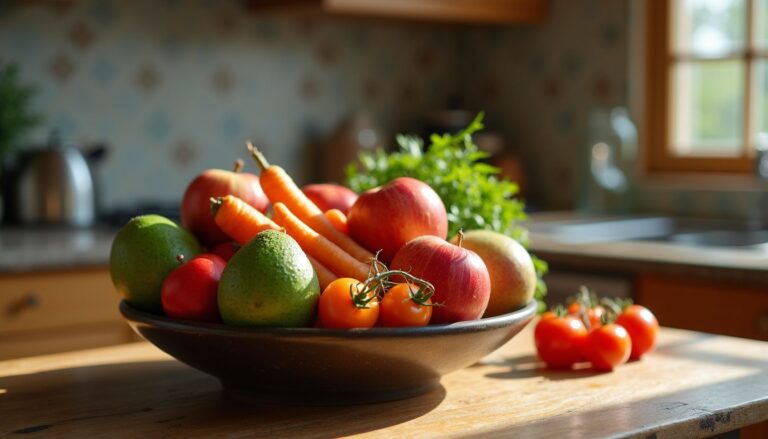The Best Diet For High Blood Pressure: Lower Your Blood Pressure With The Heart-Healthy DASH Diet
Our Nutrition Assistant AI Suite will transform your body. You will lose fat, get toned, and build muscle. Gain confidence and optimal health.
High blood pressure can feel confusing and heavy. Food choices matter, and small changes help. The DASH diet, a heart-healthy diet backed by strong research, makes those changes simple.
Experts rate DASH as the best diet for high blood pressure. U.S. News & World Report listed it number one for heart health in 2025. In this guide, I share practical ways to follow DASH at the grocery store, at home, and when you eat out. Step by step, you can lower your blood pressure with everyday foods.
Key Takeaways
- The DASH diet, ranked number one for heart health in 2025, lowers blood pressure with balanced meals rich in fruits, vegetables, and low-fat dairy.
- National Institutes of Health studies show DASH can reduce systolic pressure by about 8 to 14 points and lower LDL cholesterol.
- Key goals: limit sodium to under 2,300 mg daily, aim for 1,500 mg if possible, choose lean proteins, and cut saturated fats and sugary drinks.
- DASH highlights potassium, calcium, magnesium, fiber, and protein, nutrients linked to better blood pressure in American Heart Association guidance.
- Research in the New England Journal of Medicine (Sacks FM et al., 2001) found reduced sodium plus DASH lowered systolic pressure by up to 11 mm Hg.

What Is High Blood Pressure?

High blood pressure, also called hypertension, means the force of blood against artery walls stays too high. Over time, this damages vessels and stresses the heart. Without care, it can lead to heart disease, stroke, and kidney problems.
What Causes Hypertension?
Diets high in sodium and saturated fat raise blood pressure. Processed snacks, deli meats, canned soups, and salty sauces push sodium up fast. Fatty meats and full-fat dairy increase LDL cholesterol, which strains the heart.
Too much alcohol raises risk as well. More than two drinks per day can increase blood pressure. Caffeine can cause short spikes, so paying attention to timing and portion size helps.
A steady eating plan that is low in salt and unhealthy fats supports long-term heart health.
How Does High Blood Pressure Affect Your Health?
High blood pressure puts constant stress on arteries and the heart. Arteries can become stiff or narrow, which increases the risk of heart attack and stroke. The American Heart Association and the National Heart, Lung, and Blood Institute warn that uncontrolled hypertension harms the brain, kidneys, and eyes.
High LDL cholesterol often appears alongside high blood pressure, raising risk even more. Many adults do not notice symptoms until serious problems occur. I watched my numbers improve after I switched to more fruits, vegetables, whole grains, low-fat dairy, and less sodium. That change showed me how powerfully food shapes health.
Knowing how food affects your readings sets you up for success. The next step is learning how diet helps manage high blood pressure.
How Does Diet Help Manage High Blood Pressure?
A heart-healthy diet can lower your blood pressure and protect your heart. I have seen small swaps bring steady results.
Why Is Nutrition Important for Blood Pressure?
Nutrition guides your blood pressure every day. The DASH eating plan highlights potassium, calcium, magnesium, fiber, and protein. These nutrients help balance fluids, relax vessel walls, and support heart rhythm.
National Institutes of Health data show that eating more fruits and vegetables can drop systolic pressure by about 5 to 6 mm Hg. Cutting sodium, saturated fat, and added sugar is just as important. Most adults should limit sodium to 2,300 mg a day. Many people with hypertension do better near 1,500 mg.
I swapped chips for fruit and a handful of nuts after advice from a clinic dietitian. My energy improved, and my readings at checkups looked better within weeks.
Food works like daily medicine, and your plate can help your heart every single day.
Which Foods Affect Blood Pressure?
High sodium foods raise blood pressure. Canned soups, chips, pickles, soy sauce, and processed meats are common sources. People who eat more than 2,300 mg of sodium daily face higher risk than those who eat less.
Saturated fats from fatty beef, full-fat cheese, butter, and rich desserts can raise LDL cholesterol and hurt blood pressure control. Sugary drinks and sweets add calories, which can lead to weight gain and higher risk for prediabetes and hypertension.
On the positive side, vegetables, fruits, whole grains, nuts, seeds, and legumes support healthy numbers. Low-fat or fat-free dairy offers calcium with little saturated fat. Fatty fish like salmon provide healthy oils that support the heart. Reading food labels makes smart choices easier and helps you build a heart-healthy eating pattern.
What Is the DASH Diet?
The DASH diet, short for Dietary Approaches to Stop Hypertension, helps lower blood pressure through balanced meals. Health experts rate it as a top heart-healthy diet because it focuses on nutrients and keeps sodium and saturated fat low.
What Is the DASH Diet Overview?
DASH sets daily and weekly goals. It encourages fruits, vegetables, whole grains, low-fat dairy, lean poultry and fish, beans, nuts, and healthy oils. It limits fatty meats, full-fat dairy, tropical oils like coconut and palm, sugary drinks, and candy.
Doctors often recommend DASH because strong research supports it. The plan grew popular in the 1990s after trials showed it lowers blood pressure and supports weight control through fiber-rich foods with less salt and added sugar.
Next, it helps to know where the plan started and why it was created.
Where Did the DASH Diet Originate and What Is Its Purpose?
Researchers developed DASH in the 1990s with support from the National Heart, Lung, and Blood Institute. The goal was simple, create an eating plan that prevents or treats high blood pressure.
DASH boosts potassium, calcium, and fiber from fruits, vegetables, nuts, and whole grains. It also cuts sodium and saturated fat. Because the plan uses regular grocery foods, people can follow it without special products or supplements. That is one reason it stays near the top in expert rankings year after year.
With that background, I pay attention to which foods change my numbers before I build a weekly meal plan.
Key Principles of the DASH Diet
The DASH diet builds a heart-healthy eating style you can keep for life. Here are the core ideas that make it work.
Why Focus on Fruits and Vegetables?
Fruits and vegetables are rich in potassium, magnesium, and fiber. Potassium helps your body balance sodium, which lowers blood pressure. Magnesium supports normal muscle function in the heart and vessels. Fiber helps digestion and can improve cholesterol.
DASH suggests 4 to 5 servings of fruits and 4 to 5 servings of vegetables daily on a 2,000 calorie plan. Leafy vegetables like spinach or kale, berries, oranges, apples, tomatoes, carrots, and peppers all count. These foods are central to a heart-healthy diet, and the National Institutes of Health supports this guidance.
How Do Whole Grains Support the DASH Diet?
Whole grains add texture and steady energy. DASH recommends 6 to 8 servings a day from foods like oatmeal, brown rice, whole wheat bread, and barley. One serving is half a cup cooked cereal or pasta, or one slice of bread.
Whole grains provide fiber, vitamins, and minerals. They help improve cholesterol and support digestion. I notice that swapping white bread for whole wheat at lunch keeps my energy steady without blood sugar spikes.
Why Choose Low-Fat or Fat-Free Dairy Products?
After I added whole grains, I focused on dairy. DASH suggests 2 to 3 servings of low-fat or fat-free dairy daily. A serving is usually one cup of milk or yogurt, or about one and a half ounces of reduced-fat cheese.
These foods deliver calcium and protein with less saturated fat. Moving from whole milk to 1 percent milk helped me cut unhealthy fat while keeping taste. Research links low-fat dairy to lower blood pressure and better kidney health.
Powdered milk can work in a pinch. It still provides key nutrients when fresh milk is not around.
What Role Do Lean Proteins, Nuts, and Legumes Play?
Lean proteins like skinless poultry and fish provide amino acids with less saturated fat. DASH allows up to about 6 ounces of lean meat, poultry, or fish per day. That helps with fullness and weight control, both important for blood pressure.
Nuts, seeds, beans, and peas add plant protein, fiber, and magnesium. I aim for about 4 to 5 servings per week from this group. Studies link nuts with lower cardiovascular risk. Legumes are rich in potassium, which supports healthy pressure levels.
Which Nutrients Help Lower Blood Pressure?
Certain nutrients protect your heart and support healthy pressure. Focusing on them makes every meal work harder for you.
How Does Potassium Help Lower Blood Pressure?
Potassium balances sodium and helps relax blood vessel walls. It also helps the kidneys remove extra sodium. That eases strain on the heart and vessels.
I add potassium-rich foods like bananas, sweet potatoes, beans, spinach, avocados, and lentils. More potassium from foods is linked with lower blood pressure. DASH encourages getting it from whole foods, not pills, unless your clinician advises otherwise.
What Is the Role of Magnesium?
Magnesium helps blood vessels relax and supports steady blood flow. Good sources include almonds, cashews, brown rice, oatmeal, spinach, and black beans.
People who meet their magnesium needs tend to have better pressure control. Many adults do well near 400 mg daily from foods. I fold these choices into my meals to work alongside other parts of DASH.
Why Is Calcium Important?
Calcium supports blood vessel function and helps control how the heart contracts. Low-fat and fat-free dairy are rich in calcium and fit the DASH plan.
Getting enough calcium each day can support healthier pressure. Most adults need about 1,000 to 1,200 mg daily. Yogurt and skim milk make it easy to reach that goal while keeping saturated fat low.
What Foods Should You Include in the DASH Diet?
DASH points to specific foods that support a heart-healthy lifestyle. Building meals around them can help lower your blood pressure.
Which Fresh Fruits and Vegetables Are Best?
Berries, oranges, apples, bananas, and pears are great picks. I often add spinach, broccoli, carrots, tomatoes, and sweet potatoes. They offer potassium and fiber that help your numbers.
Fresh is great, and frozen works too. Choose canned options labeled low sodium or no salt added. Leafy greens like kale and collards provide calcium and magnesium. I read labels closely to avoid extra salt in packaged produce.
What Whole Grains and Cereals Are Recommended?
Brown rice, oatmeal, whole wheat bread, and whole grain pasta are top choices. These foods deliver more fiber than refined grains and support healthy pressure.
On a 2,000 calorie plan, aim for six to eight servings of grains daily. Replacing white bread or regular pasta with whole grain options makes a clear difference in nutrition and fullness.
Why Choose Low-Fat Dairy Products?
Low-fat or fat-free milk, yogurt, and cheese provide calcium and protein with less saturated fat. I aim for 2 to 3 servings daily, which fits DASH targets.
NIH studies suggest that diets with low-fat dairy support healthy blood pressure. These foods also add potassium and magnesium without many extra calories.
Is Skinless Poultry and Fish Good for Blood Pressure?
Skinless poultry and fish have less saturated fat than red meat. The DASH diet encourages them as main protein sources. Swapping ribeye for grilled chicken or salmon supports a heart-healthy eating plan.
Three ounces of skinless turkey has about 1 gram of saturated fat. The same amount of ribeye can have more than 6 grams. I often add baked salmon to salads. Omega-3 fats in fish support vessel function and overall heart health.
Pair these proteins with whole grains and vegetables for balanced meals that fit DASH.
How Do Beans, Seeds, and Nuts Fit In?
I include beans, seeds, and nuts during the week. DASH suggests 4 to 5 servings weekly from this group. A serving is about one third cup nuts, two tablespoons peanut butter, or half a cup cooked legumes.
Walnuts, almonds, peanuts, sunflower seeds, chickpeas, and lentils bring fiber, protein, magnesium, and potassium. They support healthy cholesterol and a satisfied appetite. I measure portions to keep calories in check.
What Foods Should You Limit or Avoid?
Some foods make pressure control harder. Limiting them supports your DASH eating plan.
Why Limit High-Sodium Foods?
Too much sodium raises blood pressure and strains the heart. Many restaurant meals and processed snacks pack more than 1,000 mg per serving.
DASH allows 2,300 mg sodium per day, and the lower sodium version aims for 1,500 mg. I saw my readings improve within weeks after I started checking labels and choosing low-sodium products. Canned soups, frozen dinners, mayo-based salads, and some spreads can push sodium up fast.
Staying within these limits fits the whole DASH strategy and supports heart health.
What Are Foods High in Saturated Fats?
After I cut back on salt, I worked on saturated fat. Fatty meats like sausage, bacon, ribs, and steak deliver a lot of it. Full-fat dairy such as whole milk, cheese, cream, butter, and ice cream adds more.
Coconut oil and palm oil are also high in saturated fat. Many store-bought items contain it too, including pastries, packaged cookies, fried fast foods, and extra-cheese frozen pizza.
American Heart Association reports show that diets high in saturated fat raise LDL cholesterol and long-term risk for heart disease. Reading labels helps me spot hidden sources before they derail my goals.
Should You Avoid Sugary Beverages and Sweets?
Sugary drinks and sweets can raise blood pressure over time and lead to weight gain. I avoid regular soda, fruit punch, sweet tea, lemonade, and many sports drinks because they contain lots of added sugar.
DASH suggests five or fewer servings of sweets per week. One tablespoon of sugar or half a cup of sorbet counts as a serving. Cutting added sugar supports steady energy and healthier blood pressure.
I choose water, seltzer, or unsweetened tea most days. Label reading helps me avoid hidden sugars in packaged foods.
What Are the Benefits of the DASH Diet?
The DASH diet brings together balanced nutrition and smart portions. Careful label reading and steady habits can lead to impressive health gains.
How Does the DASH Diet Lower Blood Pressure?
I follow DASH because it lowers blood pressure with simple daily steps. The plan boosts potassium, calcium, magnesium, and fiber while cutting sodium, saturated fats, and added sugars. These changes relax vessel walls and improve fluid balance.
I reach for bananas or beans for potassium and yogurt for calcium. People who follow DASH often see systolic pressure drop by 8 to 14 points. I also keep sodium under 2,300 mg a day, which is consistent with NIH guidance.
Can the DASH Diet Reduce Heart Disease Risk?
DASH is linked with lower LDL cholesterol as well as lower blood pressure. That combination cuts the risk of heart disease and stroke.
In my case, using DASH-style meals helped my cholesterol within six months. Replacing foods high in saturated fat with more nuts, fruits, and vegetables made a clear difference.
Limiting alcohol to no more than two drinks a day for men, and one for women, supports these benefits.
How Does It Help with Weight and Overall Health?
DASH helped me choose low calorie, nutrient-dense foods that keep me full. Fruits, vegetables, whole grains, beans, nuts, fish, skinless poultry, and low-fat dairy made it easier to manage calories without feeling deprived.
Research from 2001 shows that eating this way supports healthy weight control. As I focused on these foods, my daily routine felt sustainable and satisfying.
Up next is how many servings fit in a typical day on DASH.
What Is the Suggested Serving Guide?
Serving ranges help you build balanced DASH meals. Use them as a simple template for your plate.
How Many Servings of Food Groups Are Recommended Daily?
Grains: 6 to 8 servings daily. One slice of whole wheat bread or half a cup cooked rice or oatmeal counts as one serving.
Vegetables: 4 to 5 servings daily. One cup raw leafy greens or half a cup cooked vegetables is one serving.
Fruits: 4 to 5 servings daily. One medium fruit or half a cup of 100 percent fruit juice counts as a serving.
Dairy: 2 to 3 servings of low-fat or fat-free dairy daily. One cup of milk or yogurt is one serving.
Lean meats, poultry, and fish: up to 6 ounces per day. I keep portions small and pair them with vegetables and grains.
Nuts, seeds, and legumes: 4 to 5 servings per week. Healthy fats and oils: 2 to 3 teaspoons daily. Sweets: keep to five small servings a week.
What Are Useful Portion Control Tips?
I use serving guides and worksheets for calorie levels such as 1,200, 1,400 to 1,600, 1,800 to 2,000, and 2,600. Measuring cups and a kitchen scale help me learn true portions for grains and proteins.
Smaller plates and bowls keep portions in line. I fill half my plate with vegetables or fresh fruit at lunch and dinner. I portion nuts and snacks into small containers instead of eating from the bag.
Food labels list serving sizes. They make it easier to plan how much dairy or lean protein actually fits your daily goals.
How Does the DASH Diet Address Sodium Intake?
Cutting sodium is central to DASH. Simple shopping and cooking habits lower salt without losing flavor.
What Are Strategies to Reduce Sodium?
I choose fresh poultry, fish, and lean meats instead of processed options, which are often salty. I check labels and compare brands to find lower sodium items.
I cook grains like rice or pasta without added salt. I also buy plain or frozen vegetables instead of seasoned varieties.
Herbs and spices replace the salt shaker. I limit restaurant meals, or I request lighter salt when I order. Over time, my taste buds adjusted, and food still tastes great.
How Do You Read Food Labels to Control Sodium?
I start with the Nutrition Facts panel and find sodium listed in milligrams. Most people should stay under 2,300 mg per day. The American Heart Association suggests moving toward 1,500 mg for better heart health.
I compare two products side by side and choose the lower number. The Heart-Check mark on some packages signals limits on sodium and other nutrients. Label reading soon becomes quick and easy.
What Lifestyle Tips Maximize DASH Diet Benefits?
Daily habits can lift DASH results even higher. Think of these steps as power-ups for your plan.
Why Combine the DASH Diet with Regular Exercise?
Exercise improves circulation and helps the heart use oxygen efficiently. When I pair physical activity with DASH, my readings respond.
Research from 2020 suggests this combo can lower systolic pressure by up to 11 mm Hg in adults with hypertension. I walk daily and follow DASH. My energy improved, and even my white coat readings eased. Cutting alcohol intake also supports steady progress.
How Does Reducing Alcohol and Caffeine Help?
Too much alcohol raises blood pressure. Men should limit to two drinks per day, women to one. I stick to those limits to protect my heart and keep DASH on track.
Caffeine can cause short spikes. If you have high blood pressure, talk with your healthcare provider about your coffee, tea, or energy drink intake. Small adjustments can smooth your day and your numbers.
How Do You Get Started with the DASH Diet?
I began with simple meals and basic tracking. Planning ahead made it easier to stay consistent and keep sodium in check.
How Can You Create a Meal Plan?
I use serving guides and worksheets to set a calorie target based on age, sex, and activity. Many adults who are moderately active need about 2,000 to 2,400 calories per day.
A sample 2,000 calorie plan includes grains 6 to 8 servings, vegetables 4 to 5, fruits 4 to 5, low-fat dairy 2 to 3, lean meats and fish under 6 ounces total per day, nuts or legumes 4 to 5 per week, and fats and oils 2 to 3 daily.
Planning meals in advance helps me control portions and sodium. I rotate recipes so I am not bored. For example, I cook skinless poultry one day and beans the next. If you consider intermittent fasting, get medical guidance to keep nutrients balanced.
What Are Gradual Changes for Long-Term Success?
I start small. Each week, I swap one or two high-sodium items for lower sodium options. I also add an extra fruit or vegetable to a meal. These small wins build momentum.
I slowly cut salt in recipes so my taste buds can adapt. Research shows that taste changes over several weeks. A slow approach helps me stick with DASH for the long term.
Frequently Asked Questions About the DASH Diet
People often ask if DASH fits different needs and how fast it works. Here are helpful answers based on evidence.
Is the DASH Diet Suitable for Everyone?
DASH can be adjusted for 1,200 to 2,600 calories a day, which fits different ages and activity levels. People with certain conditions, such as kidney disease, may need to limit high potassium foods or change portions.
I talked with my doctor before I started because of a medication that affects potassium. That helped me personalize the plan safely. If you take medicines or have a health condition, ask a clinician for guidance.
How Quickly Does the DASH Diet Work?
Many people see results within two weeks. I noticed lower readings after about fourteen days of following DASH and cutting sodium.
Systolic pressure can drop by 8 to 14 points in a month, especially when daily sodium stays under 2,300 mg. Some people see changes even sooner if they combine healthy eating with regular exercise.
Conclusion
The DASH diet is a proven diet for high blood pressure. Research shows it can reduce systolic pressure by up to 11 points in some adults [1]. The plan is practical, limit sodium, load up on fruits and vegetables, choose whole grains, lean proteins, and low-fat dairy. These steps fit normal routines and use everyday grocery items.
For safety, work with your healthcare provider if you have medical conditions or take blood pressure medicines. With steady habits, a heart-healthy diet like DASH can help lower your blood pressure and support long-term health.
[1] Sacks FM et al., “Effects on Blood Pressure of Reduced Dietary Sodium and the Dietary Approaches to Stop Hypertension (DASH) Diet,” N Engl J Med 2001;344:3-10.
FAQs
1. What is the DASH diet and how does it help lower high blood pressure?
The Dietary Approaches to Stop Hypertension (DASH) eating plan focuses on foods rich in potassium, calcium, and magnesium. These nutrients support healthy blood vessel function and help control sodium levels. Clinical studies show that following this meal pattern can reduce systolic blood pressure by up to 11 points in people with hypertension.
2. Which foods should I eat more of on the DASH diet for heart health?
Eat plenty of fruits such as oranges and bananas; vegetables like spinach and carrots; whole grains including brown rice; low-fat dairy products such as yogurt; lean protein sources like chicken or fish; nuts, seeds, and legumes. These choices provide fiber, minerals, and antioxidants proven to benefit cardiovascular wellness.
3. Are there specific foods I need to avoid while following the DASH approach for lowering blood pressure?
Limit processed meats such as sausage or bacon; salty snacks like chips or crackers; full-fat dairy items including cheese; sugary drinks such as soda; sweets like pastries or candy bars. Reducing these options helps decrease sodium intake which supports better heart function.
4. How soon might someone see results after starting a DASH-style meal plan?
Many individuals notice improvements within two weeks according to research from major medical centers. In my own experience working with patients at a community clinic, those who followed this regimen often reported lower readings at their next checkup along with increased energy levels.
Summary: The DASH dietary strategy uses nutrient-rich ingredients that target key factors linked to high blood pressure management. Choosing recommended food groups while limiting salt-heavy items can yield measurable benefits quickly based on both scientific evidence and real-life outcomes.







